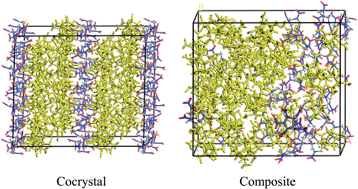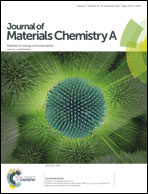Comparative study on structure, energetic and mechanical properties of a ε-CL-20/HMX cocrystal and its composite with molecular dynamics simulation
Abstract
Molecular dynamics (MD) simulation was conducted for a ε-CL-20 (2,4,6,8,10,12-hexanitro-2,4,6,8,10,12-hexazisowurtzitane) crystal, a β-HMX (1,3,5,7-tetranitro-1,3,5,7-tetrazocane) crystal, a ε-CL-20/HMX cocrystal and its composite with the same molar ratio as in the cocrystal using a COMPASS force field with NPT ensemble at different temperatures. The maximum bond length (Lmax) of the N–NO2 trigger bond, cohesive energy density (CED) and binding energy (Ebind) between HMX and CL-20 molecules as well as elastic properties were calculated. Lmax increases with rising temperature and is found to be in the order of ε-CL-20/HMX cocrystal < CL-20/HMX composite < ε-CL-20 crystal at the same temperature. CED and Ebind of the cocrystal decrease with increasing temperature and are all greater than those of the composite at the same temperature. These indicate that the cocrystal is the most insensitive and its thermal stability is better than that of the composite. Furthermore, the pair correlation function g(r) analysis reveals that hydrogen bonds exist. The tensile modulus (E), bulk modulus (K) and shear modulus (G) of the ε-CL-20/HMX cocrystal and the composite are smaller than those of ε-CL-20 and β-HMX crystals and decrease with increasing temperature. However, the K/G values of the cocrystal and the composite are larger than those of the other two crystals, implying that they have better ductility.


 Please wait while we load your content...
Please wait while we load your content...